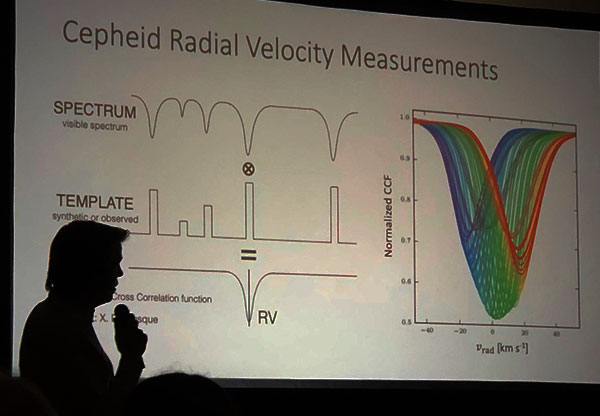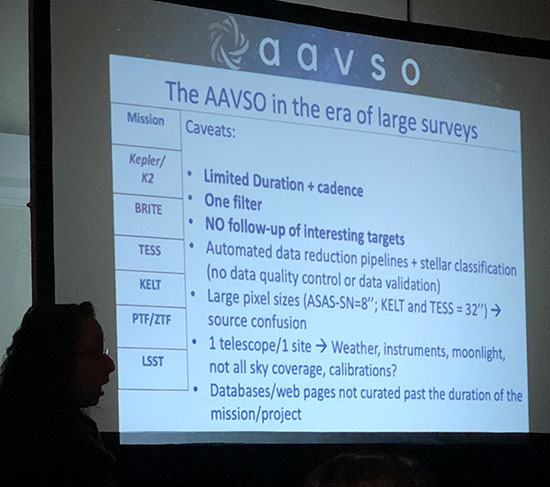Ok, so here we are ready for the two day AAVSO meeting in Las Cruces, New Mexico.
Before selecting a few topics from the meeting for a short summary here, we should have a short introduction to variable stars. Let's do a bit of homework and check out this diagram of types of variable stars, which can be found at:
https://www.space.com/15396-variable-stars.html
We see right away that some stars have variable light output because of internal dynamics and other stars have variable light output because of eclipsing type external dynamics. The referenced webpage has a short description of each of these types so check that out for the details.
 eteetA eteetA |
| Classification of Variable Stars (Source: www.space.com) |
The 108th annual meeting of the American Association of Variable Star Observers (AAVSO) in Las Cruces was begun with a summary by Dr. Stella Kafka, AAVSO CEO. The meeting had many technical sessions and some sessions dealing with AAVSO business and member strategic planning. The AAVSO has over 1200 members, worldwide, and maintains a database of something like 40 million observations on about 1.4 million stars. AAVSO President Gordon Myers also presented some introductory and welcoming comments. light curve photometry you are not going to be all alone. You can get help and compare your measurements with others in the database. AAVSO offers tools, tutorials and the large database so that if you want to do your own They describe how the AAVSO members are actively sought to help collaborate on professional astronomical studies, because the professionals don't have the luxury of point their scopes at any object they want or at any time that they want. I also didn't realize that the big aperture scopes are saturation limited on targets, brighter than say 14 magnitude.
 |
| Stella Kafka, AAVSO CEO, opens the 108th AAVSO meeting in Las Cruces (Source: Palmia Observatory) |
There were many interesting presentations and I have selected to provide just some brief comments on the characteristics of Cepheid and RR Lyrae variable stars and on novae. One of Richard Anderson's (ESO) slides identified the nature of Classical Cepheids. Remember that the Leavitt Cepheid period-luminosity relationship is a key part of the cosmic distance ladder.
 |
| What are classical Cepheid variables by Richard Anderson, ESO (Source: 108th AAVSO meeting) |
Dr. Karen Kiremuchi, Apache Point Observatory, had a slide that characterized the difference between Cepheids and RR Lyrae stars. Cepheids are younger and brighter than RR Lyrae class stars and can be used to measure longer distances. Cepheids tend to have longer periodic pulsation times so that you have to measure them longer in order to get the period-luminosity function down. For me, trying to measure the shorter period (0.05 to 1.2 days) might represent a more doable project.
 |
| Karen Kiremuchi, APO, compares Cepheid and RR Lyrae stars (Source: 108th AAVSO Meeting) |
Looking into the physics as to why these stars pulsate is an ongoing research area. As stars move off the main sequence and transition to the instability strip, this seems to be where we find these kind of stars. We will have to study this more because I don't quite understand what is going on when a star is in the instability strip.
 |
| Melanie Crowson, APUS, on spectral classes and instability strip (Source: 108th AAVSO meeting) |
Richard Anderson, with European South Observatory (ESO) in Chile, discussed how using the radial velocity method to detect exoplanets orbiting a star gets complicated because the stars' internal dynamics can result in its radius expanding and contracting in a mostly periodic manner. So the search for exoplanets needs to correctly analyze and remove any radial velocity components due to internal dynamics from any radial velocity components due to an exoplanet.
 |
| Richard Anderson, ESO, describes Cepheid radial velocity measurements (Source: 108th AAVSO Meeting) |
Here is an example of a radial velocity curve due to internal dynamics for a Cepheid variable. We know there is a period-luminosity relationship for Cepheids and this curve shows the velocity of expansion and contraction of the star. If you are trying to search for an exoplanet around a variable star you have to disentangle the variable velocity of the star itself from any gravitational tugging of an exoplanet which will also show up as part of the radial velocity measurement.
 |
| Example of Cepheid radial velocity curve (Source: www.mb-soft.com |
There were a lot more details on that topic but for now let's switch to another variable star category and that is the nova class. First we should remember that there are many novae, maybe ten times as many as what we call supernovas. The textbook nova does not explode and turn into a neutron star or black hole, but can erupt In somewhat many times in a periodic fashion. Material, say from a red giant partner of a binary white dwarf can accrete on the star and erupts in a burst of nuclear fusion and ejects a portion of the accreted material.
In the slide below, Fred Walter showed a textbook nova and you can see how during the eruption the light curve peaks quite rapidly and then slowly declines in output. At the same time, the spectra in different wavelengths shows that different processes are going on at distinct intervals during the eruption. That is pretty neat and is one of the reasons that I want to combine doing spectroscopy at the same time as light curves. Also do you see the gap in the light curves? The author did not say, but to me that is probably caused by the targeted object moving behind the sun or otherwise not visible. I know for me, gaps in light curves in data I have collected in the past was because I got tired and called it a night and came back the next time to finish the job.
 |
| Fred Walter discusses nova evolution by spectra and time (Source: 108th AAVSO meeting) |
The novae in addition to providing a window into interesting physics going on inside the star also. The effects of the novae outburst included the formation of more lithium and isotopes of carbon, nitrogen and oxygen, but also recycling of elements into the interstellar medium (ISM) and the creation of dust. Hmm, so that is where most of the dust is formed!
 |
| Fred Walter discusses why novae are important (Source: 108th AAVSO meeting) |
 |
| Stela Kafka, AAVSO CEO, explains new spectra/light curve database (Source: 108th AAVSO meeting) |
Some AAVSO members worry that the database won't be needed after the professional astronomers complete the large surveys. But this is just not the case. The large surveys are very constrained on what they can observe and don't have the time or budget to go back and look at interesting targets. The professionals are interested in AAVSO being able to fill in the gap. The AAVSO has observations going back almost a hundred years and sometimes these observations are key to resolving some interesting finding that just happened to be noticed today.
 |
| Stella Kafka, AAVSO CEO, explains need for follow up observations (Source: 108th AAVSO Meeting) |
In this next slide Stella shows some of the limitations with these large surveys and AAVSO volunteer observers and analysts are ready and willing to help fill in the missing pieces. Thank you AAVSO!
 |
| Stella explains need for AAVSO observations to support large survey projects (Source: 108th AAVSO Meeting) |
Well, I'm worn out for this the second day and all that remains now is the final awards dinner with entertainment. However, during the last blog posting, the scenic views of the Milky Way were shown, but what was not shown was the attack of some silent, barely audible buzzing New Mexican native, attacked this Resident Astronomer, resulting in these swollen (lobster claw) hands. Hmm, astronomers have it bad, when we are not being attacked as in "The Night of the Living Dead" it is here in the dark skies of Las Cruces. So, the next time you see an astronomer, thank them for putting up with the risks and dangers of the job, just to get a photo for you or data or later analysis! Fortunately, Resident Astronomer Peggy put on her nursing hat and said, "get yourself to CVS and get some Benadryl." Thanks Peggy, that helps a lot!
 |
| Lobster hands, aka Resident Astronomer, display insect bite swollen hand(s) (Source: Palmia Observatory) |
Until next time,
Resident Astronomer George
Be sure to check out over 300 other blog posts on similar topics
If you are interested in things astronomical or in astrophysics and cosmology
Check out this blog at www.palmiaobservatory.com

No comments:
Post a Comment